#Walstad method
Explore tagged Tumblr posts
Text
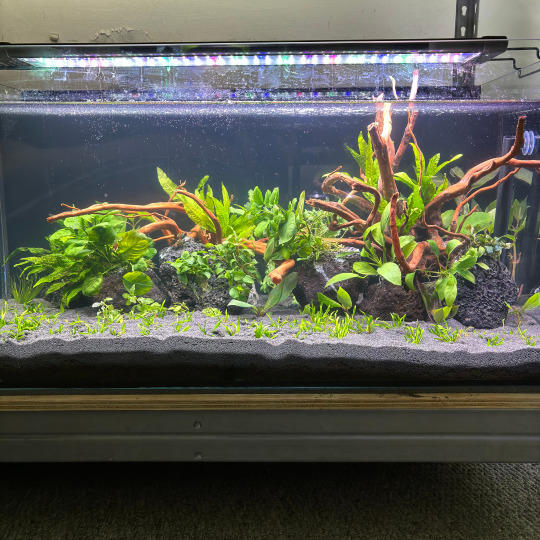
Apex Predator Walstad Method Tank Is Planted!
The initial ammonia released from the soil has already converted to nitrite, likely thanks to the beneficial bacteria colonies on the plants and lava rock, which were in one of my betta tanks for almost a year.
I’m holding off on adding the food web insects until algae and biofilm have had time to establish and the nitrite has fully cycled out.
So far, everything is progressing as planned!
Plant List
🌿 Java Fern 🌿 Java Fern Green Gnome
🌿 Bucephalandra Red Scorpio
🌿 Bucephalandra Sintang
🌿 Bucephalandra Theia Green
🌿 Anubias Glabra
🌿 Anubias Coin Leaf
🌿 Anubias Petite
🌿 Hygrophila Corymbosa
🌿 Hygrophila Corymbosa Compact
🌿 Hygrophila Difformis
🌿 Blyxa Japonica
🌿 Helanthium Tenellum Green
🌿 Red Root Floaters
5 notes
·
View notes
Text
I mostly write about organisms and not the principles of fishkeeping. However people often ask me about two related phenomena, cycling and stocking. Aquariums are safe for fish and other animals because of the nitrogen cycle. This is what determines, moreso than the water volume, the carrying capacity of the tank. But many people seem to be confused - what is the nitrogen cycle?
'Cycling' refers to the cycle by which the toxin ammonia, which is excreted as waste by organisms, before it is turned to nitrite and then to nitrate by biological actors. In aquarist parlance 'cycling' refers to the process and duration of time, during which the nitrogen cycle becomes established and stable. Properly the cycle continues throughout the operation of the aquarium.
Ammonia, which contains nitrogen, is the principal excretory product of living animals, and they void it because it is a toxic byproduct of their own metabolic processes. Human urination is an example of a way in which animals lose excess ammonia, but other kinds of animal may excrete ammonia by means of different methods.
Fortunately other organisms can find a positive use for ammonia, which animals don't want. Their own metabolisms create nitrite from the ammonia they intake, by breaking it down and adding oxygen to the nitrogen. Then yet more microscopic organisms convert the nitrite to the similarly named and chemically related nitrate, which must also be maintained at low levels, but is far less harmful. Traces of nitrate are in fact beneficial to some aquarium organisms.
The nitrogen cycle originates from the decomposition of amino acid, and this is why test kits are available to test for dissolved organics, which are not themselves inherently harmful, but their buildup indicates strain upon the system. How much strain is acceptable depends on the kinds of animals that are living in the aquarium. There isn't really a single standard as to when there are too many dissolved organics, or even nitrate. But regular and sensibly proportionate water changes, help to keep both under control.
Because it involves the processes of different organisms, the nitrogen cycle is very obviously an ecological, as well as a chemical phenomenon. Both the natural processes of the cycle, and the technology by which the effects of the benign organisms are maximised, are known as biological filtration, or biofiltration. It is different from physical and chemical filtration, although the functions of filter media may overlap.
The good bacteria that are involved, colonise available surfaces throughout the aquarium. They are present on rocks and on substrates such as sand and gravel. Similarly they colonise sponges and various proprietary items such as 'bio balls'. At this point, I wish to explain the introductory principles of biofiltration, not to cover its different expressions. It is however worth pointing out, the more the better.
Stocking levels are problematic principally because the living animals themselves create strains upon the biofiltration. Furthermore they require inputs of food, excesses of which contribute to dissolved organics, and therefore the nitrogen cycle, when they are uneaten - thus, messy feeders create more bioload than other organisms, lowering the carrying capacity of the aquarium system.
Feeding behaviors thus determine the 'footprint' animals have on the biofiltration in their aquarium, moreso than their size. It is also the mass of an animal that contributes to its output of wastes, moreso than any single dimension, such as its total length. Another determinant is the metabolic rate of the animal in question, which determines the speed at which its wastes are generated and churned out into the water.
The nitrogen cycle is also why overfeeding is bad, because excess food must inevitably decompose. By definition, the aquarist can't be overfeeding, from the perspective of the nitrogen cycle, when the supplied food is being eaten; overfeeding as in overeating is a different problem. However if feeding your livestock and keeping them healthy begins to stress the cycle, then you have too much bioload in your aquarium.
Often in marine aquariums, 'live rock' and 'live sand' are mentioned. These terms mystify many people, although they are relevant to filtration. The rocks and sand in question are substrates already colonised by microscopic organisms, as play a role in the nitrogen cycle. All items already this colonised are thus 'live' biofiltration media.
Unfortunately there is a misconception that 'live' rock needs transporting from the sea. Such rock is shipped damp but emersed, killing benign and desirable organisms, and necessitating a period called 'curing' in which photosynthesizers are denied an energy source, and further mortality and decomposition ensues. The result is that only 'tough as boots' organisms survive, and some of these species are harmful to corals and such.
Clearly despite the appeal of 'live rock' as a ready made, natural reef, it's use is problematic and self defeating. A distinction just be made, between the use of 'living' filtration media, and the importation of artificially depauperate microenvironments for aquariums. It is better to take rock and sand from an established reef tank instead, to avoid unwanted guests. Although even impoverished live rock can introduce interesting and useful 'friends', these can arrive also from established, nuisance-free tanks
A counterpart to the use of live rock and sand in reef aquariums, is the Walstad style of freshwater aquarium. The Walstad type of tank is one in which living plants and soil substrates are employed instead of artificial filtration; more common than a strict Walstad setup, is a hybrid system that employs both naturalistic and 'normal' approaches in its running.
Sometimes it is said that planted tanks do not cycle, or that adding plants stops the cycle. Nothing could be further from the truth. True aquatic plants and the organisms called algae, play a role in the cycle, which is why algae bloom during the cycling period of a new aquarium, when the lighting is switched on. Adding plants to freshwater tanks, and macroalgae to marine aquariums, should be thought of as assisting the stabilisation of the nitrogen cycle.
#nitrogen cycle#ammonia#nitrite#nitrate#biological filtration#biofiltration#stocking level#overfeeding#dissolved organics#live rock#live sand#algae#plants#Walstad method#planted tanks#macroalgae
2 notes
·
View notes
Text

got the wood in!! wonder how long it'll take to sink lol. I'm hoping to attach plants all along it- the body of the branch is shaped like a nike swoosh and all those little skinny branches will poke up out of the water, so I can grow not-fully-immersed plants as well!!
#walstad aquarium#walstad method#planted tank#low tech aquarium#cherry barbs#anubis#amazon swords#java moss#dirted tank#fish
2 notes
·
View notes
Text
my girl 🩵 im so proud of how ive hidden the heater as well


#its a heated unfiltered walstad method tank#so thats potting soil under the planting gravel#the ludwigia is LOVING it i keep having to trim and replant it#the waters not all the way settled from the water change/replant here
5 notes
·
View notes
Text
the tank i have for the shrimp comes with a built-in filter, bubbler, and light that doesn't seem like it can be separated from one another to function since they all plug into the same chunk bit... this tank also has a history of killing fish WAY larger than my shrimp with this filter just as it is... so... im wondering if i can fashion a false bottom for the filter but the tradeoff is maintaining it is going to be way harder this way if not impossible... ugh....
#i know how this sounds please dont shoot to kill for this but a lot of people who keep these shrimp who run filters end up killing them#or cant get them to breed because theyre REALLY tiny and their eggs are like pepperflake sized#what im thinking i wanna try with them so i can oxigenate their water without intrusive filtration is via walstad method or false bottom#walstad shit is gonna be hard because theyre also brackish and i cant find barely any plants that grow well in soil AND brackish waters#and im thinking false bottom is my best bet for them...? i wanna read Diana Walstad's book on her method. i wonder if she mentions brackish#also im pissed off by how this tank functions as a whole because i cant use an auto-timer switch if everything's hooked up to one point -_-
2 notes
·
View notes
Text
Got "gifted" a black moor goldfish and I need some advice...
So like obvious tw for animal abuse but my coworker just deposited her fish on my desk and told me it's mine now because I "know about fish keeping" and this fish is "abusive" to her other one (lol it's eating the other one bc it was in a 5 gallon tank) and I'm having like the fucking 5 stages of grief bc I'm not prepared to take care of her fish (I HAVE 2 CATS AND SHE KNOWS THIS WTF) but I feel like it'd be actually evil to give it back to her and I'd incur a horrific karmic debt for doing so, so I'm sitting here with a fish on my desk staring at me with its big vulnerable eyes and I feel awful


I'm buying an API freshwater master kit, seachem prime, an air stone, and a 10 gallon tank with a new filter tonight but does anyone know anything about black moor goldfish?? I know it'll eventually end up in a 15 gal tank but I can't do that right now due to space + weight constraints. My coworker gave me a 2.5 gal tank and it'll be in that until I can acquire the 10 gal tank. Eventually I plan on going with a walstad method tank (when I'm able to get a spare fucking 3 months to set it up lol) but until then I am going to be doing emergency fish-in cycling with no plants and minimal decorations. I have gravel substrate but I'm not sure if I want to use that yet. Can anyone offer advice and recommendations on helpful products?
#slime speak#fish#fishposting#also for reference the water is currently clean with no nitrates nitrites or ammonia but i know its not bacteria rich water#i only used hach test strips that are available at my job bc we dont have hach test n tube for that which is what i wouldve used
16 notes
·
View notes
Text
I ordered a book about planted aquariums and stuff by the microbiologist Diana Walstad ("Ecology of the Planted Aquarium") and i am so incredibly excited because i want to make a small filter free aquarium in the future using her methods.
Foo the Flowerhorn on Youtube also made a bunch of those which is where i got that idea. (A Playlist full of them can be found here)
The only issue being that i am moving in december and it probably won't be worth it to set up a tank now only to take it down again for my move, so it'll have to wait until i get to my new apartment :(
(I just know I want shrimp and loads of vegetation, not even necessarily fish)
2 notes
·
View notes
Note
Hi I think your endangered fish tanks are so cool. That it's a connection to your dad sounds powerful too. Do you have any advice or resources for someone looking to get into native biotope tanks?
Thank you so much! Choose a species and research the heck out of it. My tank isn't actually a native biotope tank because the plants come from all over the place and I have some Asian shrimp and Cory catfish from South America while the Ameca splendens are a Mexican species, but it has a very natural look because I follow the low-tech Walstad method. She wrote a great book called Ecology of the Planted Aquarium.
If you're interested in breeding the same species as me or something similar, the website Select Aquatics sells them at a reasonable price and the owner is a good resource on their care and tank parameters. Serpa Designs is also a YouTuber who is an amazing aquascaper, and he has made tutorials on biotope tanks for Betta fish and Ameca splendens.
14 notes
·
View notes
Text


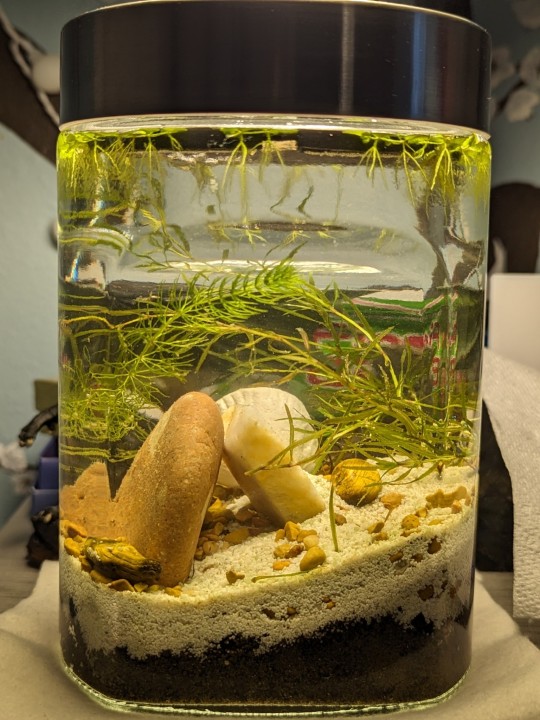
The tiny jararrium has been upgraded! The residents are now in a setup that actually has soil in the bottom more like the Walstad method, and I can't wait for the guppy grass and hornwort to fill out.
A circle of salvinia minima around a feeding ring let it have both floating plants and light from above through the clear lid. The move covered everything in brown algae debris, but the inhabitants cleaned it up pretty quick! And there are BABIES
I've counted at least 7 different species in there just that I can see without a microscope, which is amazing to me. They all came from a sample of nearby gunky lake water.
[video id: Inside a planted jar aquarium, a tiny shrimp creature crawls on a plant and then swims off in a jittery, flailing way.]
6 notes
·
View notes
Text

♛𓆣 lauren 19 it/its+ flatworm enjoyer & future zookeeper. a walstad method truther, obsessive-compulsive manic-depressive, and more.
cohost ✦ flight rising (+ blog) ✦ pillowfort ✦ spacehey ✦ spotify ✦ tlk blog ✦ website
no new followers under 18 no terfs no proshippers no ED or self-harm blogs no "pro-para" blogs no anticommunists et cetera. thanks
★ ──── remade from okcomputeroknotok19972017 <3
#additional info: my blog runs on an untagged queue‚ i mostly use desktop‚ and i really like getting asks and anons :)#this post is formatted for desktop sorry it looks kinda funny on mobile
34 notes
·
View notes
Text
Hi! I keep tarantulas, freshwater aquariums, and some miscellaneous inverts in bioactive, naturalistic set ups. This blog is meant to showcase my spiders but may also look into my other critters. Tarantulas:
Twinkleberry: Chromatopelma cyanopubescens, Green Bottle Blue, juvenile
Trundle: Hapalopus formosus 'large', Pumpkin patch, juvenile
Duck: Cyriocosmus elegans, Trinidad dwarf, juvenile
Goose: Cyriocosmus sp. tambopata, sling
Knees: Citharacanthus cyaneus, Cuban orange-violet, sling
Toes: Citharacanthus cyaneus, Cuban orange-violet, sling
Pudge (deceased): Hapalopus formosus 'large', male; purchased as a mature male, Pudge lived for six months and started it all for me.
Inverts:
Two American millipedes, Armadillidium vulgare (native) and Armadillidium maculatum 'zebra' isopods, and whatever beetles, grubs, and caterpillars may cross paths.
Aquariums:
1gal: planted low tech, no heater, no filter, Walstad method, stocked with a few cherry shrimp and microfauna
5gal: homemade planted low tech, heated and with sponge filter, Father Fish method, stocked with ember tetras and cherry shrimp
30gal: blackwater low tech, stocked with a juvenile Eastern musk turtle (Oakleaf), cherry shrimp, clams, and various tropical fish that came with the original set up

1 note
·
View note
Text
youtube
7 Walstad Method Myths Debunked: What Dianna Walstad Really Says You Should Do In Your Planted Tank!
Best Plants For Walstad Tanks - https://www.youtube.com/watch?v=FJ7BDAKkhRs Best Floating Plants - https://www.youtube.com/watch?v=vKTNC8LLD5I Worst Plants For Walstad Tanks - https://www.youtube.com/watch?v=7ftTLlRmW80
SOURCES
Book Excerpt - https://dianawalstad.com/wp-content/uploads/2023/05/nitrogen-uptake-2023.pdf Nitrate Update 1 - https://link.springer.com/article/10.1007/BF00387462 Nitrate Update 2 - https://www.sciencedirect.com/science/article/abs/pii/S221471442200873X Nitrate Update 3 - https://pubmed.ncbi.nlm.nih.gov/23033643/ Ammonia to Ammonium converter - https://extension.rwfm.tamu.edu/wp-content/uploads/sites/8/2013/09/Ammonia-in-Aquatic-Systems1.pdf Plants Use Ammonia - https://www.researchgate.net/publication/366944461_Reducing_ammonia_levels_in_catfish_cultivation_water_using_several_aquatic_plants Fritz User Guide For Fritz Zyme 7- https://fritzaquatics.com/resources/articles/fritzzyme-user-guide-fw
BRAND MEDIA KIT - https://glassboxdiaries.com/brands
7 Walstad Method Myths Debunked: What Dianna Walstad Really Says You Should Do In Your Planted Tank!
In today’s video, I’m tackling some of the most common myths about Walstad Method aquariums. These myths are widespread, and I believe content creators (myself included) play a role in perpetuating them through our titles and content. However, there’s a lot more nuance to the method than these myths suggest.
Throughout the video, I’ll share footage from my own aquariums—some that follow the Walstad Method and others that don’t.
Here’s what we’ll cover: 1️⃣ Do Walstad tanks need filters? While many believe filters aren’t used in Walstad tanks, the truth is more nuanced. Even Dianna Walstad herself uses filters in some setups. I’ll explore her recommendations and why beginners might benefit from starting with a filter—or at least adding water flow with a USB pump.
2️⃣ Are plants the only filters? Plants are amazing at absorbing harmful compounds like ammonium, nitrite, and nitrate, but they’re not the only filtration mechanism. Beneficial bacteria and archaea in the substrate play a massive role too, often working in tandem with plants.
3️⃣ Do Walstad tanks eliminate water changes? While water changes can be minimized, they’re not always unnecessary—especially in new tanks. I’ll explain why water changes might still be needed and how to manage Total Dissolved Solids (TDS) effectively without frequent water changes.
4️⃣ Do Walstad tanks avoid fertilizers? It’s possible to avoid fertilizers in a Walstad tank, but it can be challenging. I share my personal experience dealing with potassium deficiencies and some natural ways to boost essential nutrients like potassium and iron.
5️⃣ Is the research in Walstad’s book outdated? Some claim the research is old, but the latest edition of The Ecology of the Planted Aquarium (2023) includes updated studies and findings. If you’re interested in Walstad tanks, make sure to reference the newest edition.
6️⃣ Can you instantly stock a Walstad tank? Rushing to add fish can be risky, especially for beginners. I’ll explain why patience is key to allowing plants, bacteria, and archaea to establish before adding livestock.
If you’re curious about the Walstad Method or just want to improve your planted tank setup, this video is for you!
Don’t forget to check the description for links to studies, resources, and additional information mentioned in the video.
👉 Leave a comment with your thoughts or questions—I’d love to hear from you! 👍 Like and subscribe for more content on aquariums and planted tank tips!
Thanks for watching, and have a great day! 🌿🐟
TIMESTAMPS
00:00 - Intro 00:05 - Walstad Method Myths 00:23 - Walstad Tanks Don’t Use Filters 01:42 - Plants Are The Filter 05:59 - Walstad Tanks Don’t Need Water Changes 07:25 - Walstad Tanks Have Problems With TDS Build Up 09:42 - You Don’t Use Fertilizers In Walstad Tanks 12:07 - The Research Is Out Of Date 13:16 - Instantly Stocking Walstad Method Tanks
Some of the links in this video description may be affiliate links meaning I earn a small commission from any purchases made.
#aquarium#fish tank#planted tank#planted aquarium#aquarium plants#aquatic plants#walstad#walstad method#dirted tanks#dirted aquarium#Youtube
6 notes
·
View notes
Text
New blog new intro - fish yeah
Wanna meet my water dogs? Yeah you do.
Ten Gallon
• Khonshu - Galaxy Koi Plakat Betta
• 2 Adult Ramshorn Snails + their criminal amount of children
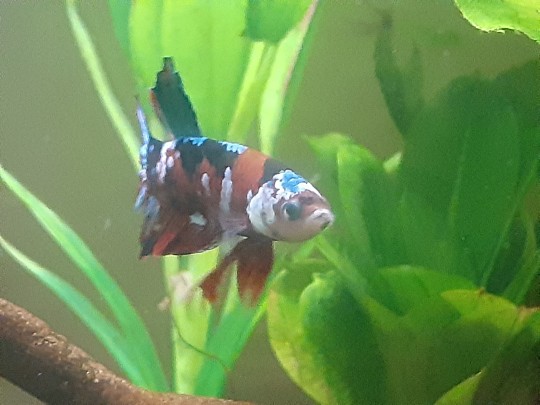
Bought this pretty boy over this summer. He's in his main character era and currently can't decide what colour he wants to be.
Konch has a liking for brine shrimp and bloodworms, and detritus worms.. and ghost shrimp. Oh and baby ramshorn snails. Quite the palate on that one. Sometimes he'll accept a rogue betta buffet pellet.
Currently in the works of getting some pipe cleaners and maybe training him some.
29 Gallon
• 10 Glowlight Tetras
• 9 Bandit Corydoras
• 2 Honey Gourami (Marner & Nylander)
• 2 Mystery Snails
• 2 Black Racer Nerite Snails


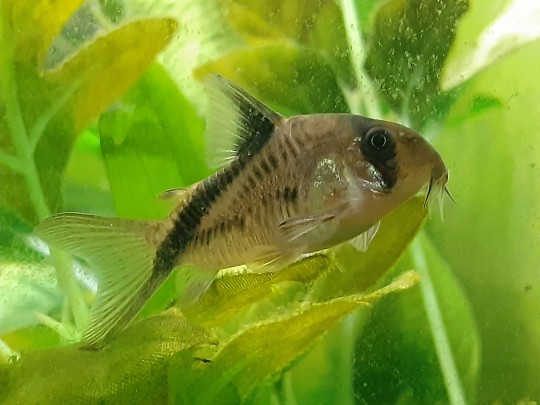
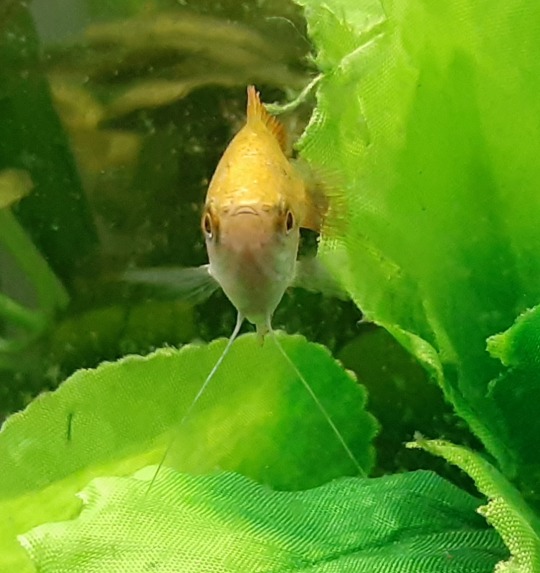
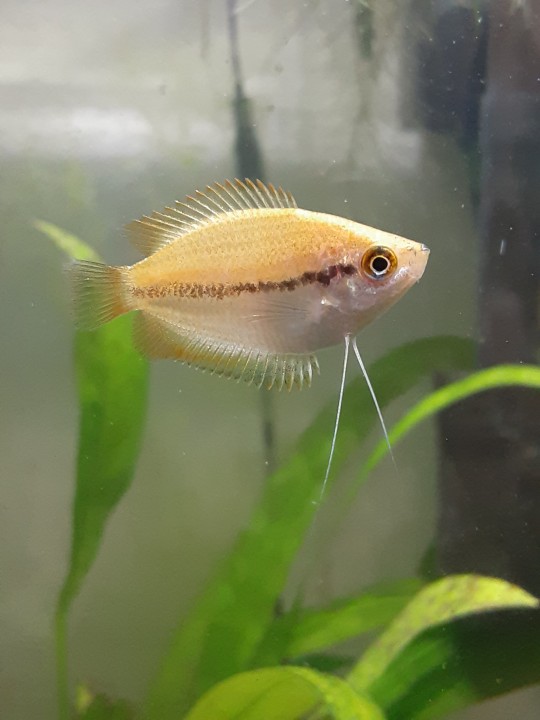

This is my fun little community tank. My little side gig if you will. Based finished, except for a final addition of a third honey gourami (hopefully soon) and possibly a third mystery snail. If the mysteries ever start to breed I could bring in some babies to the LFS and sell them. If not then that's fine and I'll take what I can get. Yes I did name my gouramis after hockey players and yes I can tell them apart by one single black scale.
Future Projects
I'd love to set up a 3rd tank, walstad method. My stocking would either be a colony of shrimp or a single betta. I'd attempt this in a 5.5 gallon. If this happens or not, who knows, but the idea is definitely there.
For future future projects, I'd love to set up a 75 gallon community tank when I get my own place. Stocking I'm unsure about, but a large school of something like swordtails or platies is something that has always captivated me.
#fishblr#betta#betta fish#glowlight tetra#tetras#tetra#corydoras catfish#corydoras#bandit corydoras#thick lipped gourami#thick lip gourami#hffmarner#hffkhonshu#hfftetras#hffcories
0 notes
Text

╰(⸝⸝⸝´꒳`⸝⸝⸝)╯ she is so beautiful!! now it's just water changes and testing until it gets perfectly balanced. I can take my time picking up plants and finding a sunrise/sunset light.
#fish#planted tank#walstad aquarium#walstad method#planted aquarium#so far the barbs are loving the sand ( ◜‿◝ )♡#decided to go with white so i can see when its dirty and will be more motivated to clean it#I was worried the plants were going to be in much worse shape than they are since i left them with only window light for a couple weeks#but they're all fine! Actually the one I threw in the big tank to help cycle it is looking the worst out of all of them#the snail (the snuderer) glommed onto the moss ball from the planted bowl cause its full of algea :)#i would love to get a daphinia bowl going so they can have fresh food to hunt....
4 notes
·
View notes
Text
ive been fixated on betta fish to some degree since early high school which is genuinely such a nightmare because everyone ever who talks about betta fish has 0 information and is getting everything wrong but i cant just butt into conversations like UM ACKSHUALLY THEY CAN LIVE A VERY LONG TIME WITH PROPER CARE i just have to sit there and suffer. also im setting up a new walstad method planted tank and really want a female betta for it once it's ready and i swear to god ever since chain pet stores started inventing all these new betta variants they can mark the price up for insanely (alien, vampire, galaxy whatever) they've just completely stopped stocking female fish. which is a shame cause i always recommended female bettas to people who came to the pet store i worked at when they expressed wanting a more active and expressive fish.
#i have the day off tuesday im gonna make a slightly annoying drive to a better pet store#if i find a little lady there i will be polling the populace for names
6 notes
·
View notes
Text
why is the walstad method aquarium reddit private. let me in on your secrets.
0 notes